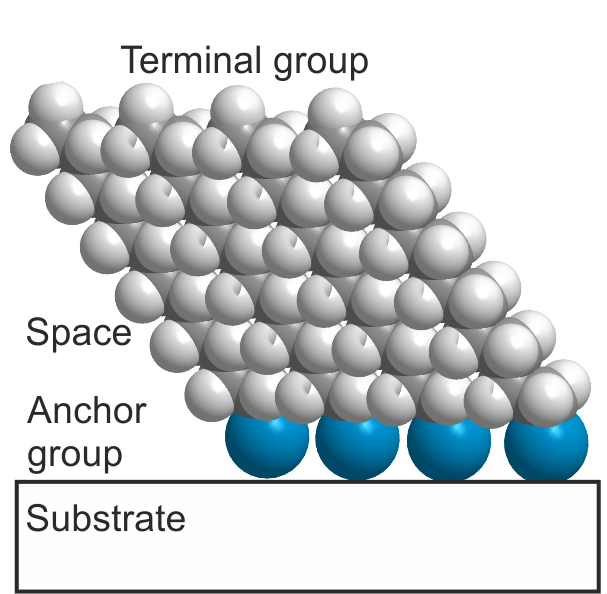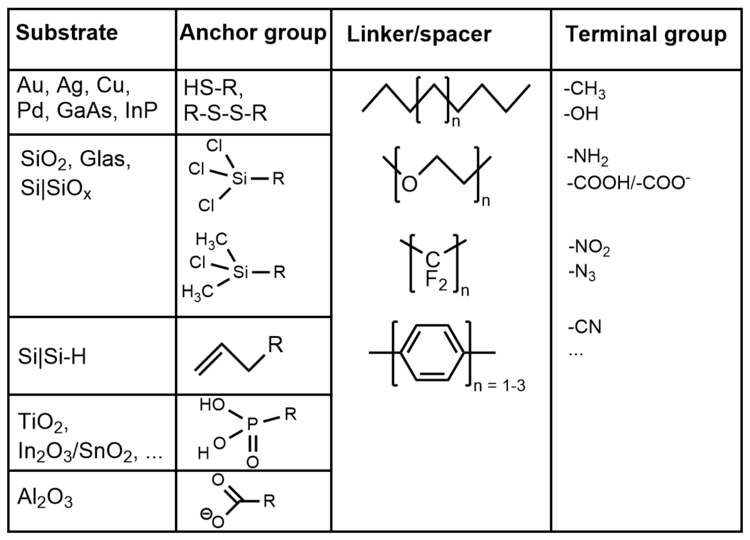Patterning of Organic Thin Films
Contact
Mailing Address
Visitors
Patterning of Organic Thin Films
Principle of Monolayer Formation
Self-assembled monolayers (SAMs) are ordered arrangements of several molecules that align with each other through intermolecular bonds. Such layers form spontaneously when chain-like, mostly unbranched molecules form a chemical bond between an adhesive anchor group to a surface and the chain-like moieties of several neighboring molecules align with each other (Figure 1). This is different to Langmuir films, where mechanical work is spent to align the molecules.

Table 1 shows examples of how monolayer formation can be achieved on different surfaces by selecting the adhesive group. In principle, the adhesive group can be connected to different chain-like molecular parts.

At the other end of the chain there may be a terminal functional group that provides the desired properties for a certain application such as a permanent charge, chemical bonding properties, hydrophobicity/hydrophilicity or protein-repellent properties. Film formation can endow surfaces with properties that the substrate alone does not possess. The chain-like part of the molecule acts as a spacer and linker between the terminal functional group desired for an application and the surface. The possibilities are further broadened by the use of mixtures of different starting molecules.
Some examples of end groups and applications are
-CH3: Hydrophobic properties, cause water-repellent properties
-CH2-OH: Hydrophilic properties, improves wetting with water
-COO-: Negative surface charge at pH less than 4
-CN: Complexation of cations, use as starting layer for growth processes of coordination network compounds
-[-CH2-CH2-O]n-CH3: Strong binding of a hydrate shell to the molecule causes protein and cell-repellent properties of the surfaces
-NH3: Covalent binding to other molecules, e.g. for anchoring proteins and nanoparticles to sensor surfaces
Patterned Monolayers
In addition to these diverse applications, the layers are also suitable for forming patterned layers on surfaces, i.e. layers in which a specific chemical structure is present on parts of a surface and a different function can be anchored at another location on the same surface. Such monolayer systems have advantages over photolithographically produced patterns when sensitive molecules such as proteins are to be bound, which would be destroyed under the conditions of other structuring processes. They are therefore suitable for modifying artificial surfaces of electrodes, components, optical fibers, etc. in a controlled manner with layers that have a defined chemical or biochemical function.
The patterning of surfaces can be carried out site-selectively by local abrasion (nanoshaving) with the tip of an atomic force microscope, by the local generation of an etchant (e.g. Br2/OBr-) at the microelectrode of a scanning electrochemical microscope or by applying suitable alternating voltages between a microelectrode and the substrate electrode under the monolayer. Another method is the writing of patterns with the wetted tip of an atomic force microscope (dip-pen nanolithography). These methods are very flexible in the research laboratory; patterns can be changed very easily for experimentation. However, the methods are quite slow because the different regions of a surface can only be approached and modified one after the other.
Parallel structuring methods act simultaneously on different areas of the surface and provide much higher throughput. They usually require a mask or other template. One mask or template can only produce one pattern; changing the pattern requires the production of a new mask or template, which can be costly and time-consuming, but then allows many copies of the modified surfaces to be produced quickly. For self-organized monolayers, a special variant of stamp printing known as micro-contact printing is suitable. The stamp consists of polydimethylsiloxane (PDMS) and is cast from a template (etched glass or silicon, pattern in an exposed photoresist). Slightly modified processes use reagents for modification, which are directed to the desired locations on the substrate surface in channels of a microfluidic networks made of PDMS.
Own Contribution to the Research Field
In our laboratory, we use SAMs in various projects and further develop structuring methods (parallelization, improved resolution), especially those that can be carried out in electrolyte solutions under conditions where previously bound proteins are stable.
Special effects can be achieved when the different structuring methods are combined. For example, biological cells can be incubated on a stamped monolayer, causing cells to adhere only in designated areas. This pattern can then be modified later in order to observe how the grown cells react to the altered properties of the supports or to introduce another cell population into the cell culture in a site-specific manner.
Patterned monolayers can be imaged and characterized with material-dependent variants of atomic force microscopy (AFM), with scanning electrochemical microscopy (SECM) and, in the case of fluorescently labelled molecules, with (confocal) fluorescence microscopy. The type of chemical groups and their transformations can be determined using surface-sensitive infrared reflection-absorption spectroscopy (PM IRRAS) and photoelectron spectroscopy (XPS).
Further Reading About Self-Assembled Monolayers and their Patterning
A. Ulman; Formation and Structure of Self-Assembled Monolayers. Chem. Rev. 1996, 96, 1533–1554. Link to paper
C. Vericat, M. E. Vela, G. Benitez, P. Carro, R. Salvarezza; Self-assembled monolayers of thiols and dithiols on gold:new challenges for a well-known system. Chem. Soc. Rev. 2010, 39, 1805–1834. Link to paper
J. J. Gooding, N. Darwish; The Rise of Self-Assembled Monolayers for Fabricating Electrochemical Biosensors-An Interfacial Perspective. Chem. Rec. 2012, 12, 92–105. Link to paper
M. Li, M. Liu, F. Qi, F. R. Lin, A. K.-Y. Jen; Self-Assembled Monolayers for Interfacial Engineering in Solution-Processed Thin-Film Electronic Devices: Design, Fabrication, and Applications. Chem. Rev. 2024, 124, 2138–2204. Link to paper
Y. Xia, G. Whitesides; Soft Lithography. Angew. Chem. Int. Ed. 1998, 37, 550–575. Link to paper
Own Examples for Applications and Patterning of Monolayers
T. Wilhelm, G. Wittstock; Analysis of Interaction in Patterned Multienzyme Layers by Using Scanning Electrochemical Microscopy. Angew. Chem. Int. Ed. Engl. 2003, 42, 2247-2250. Link zo paper
C. Zhao, I. Zawisza, M. Nullmeier, M. Burchardt, M. Träuble, I. Witte, G. Wittstock; Microelectrochemical Modulation of Micropatterned Cellular Environments. Langmuir 2008, 24, 7605-7613. Link to paper
I. Brand, M. Nullmeier, T. Klüner, R. Jogireddy, J. Christoffers, G. Wittstock; Structural analysis of the HS(CD2)12(O-CH2-CH2)6OCH3 monolayers on gold by means of polarization modulation infrared reflection absorption spectroscopy. Progress of the reaction with bromine. Langmuir 2010, 26, 362-370. Link to paper
I. Rianasari, L. Walder, M. Burchardt, I. Zawisza, G. Wittstock; Inkjet Printed Thiol SAM Structures on Gold: Quality Control and Microarray Electrode Fabrication. Langmuir 2008, 24, 9110-9117. Link to paper
M. Burchardt, G. Wittstock; Micropatterned Multienzyme Devices with Adjustable Amounts of Immobilized Enzymes. Langmuir 2013, 29, 15090-15099. Link to paper
A. Lesch, B. Vaske, F. Meiners, D. Momotenko, F. Cortés-Salazar, H. H. Girault, G. Wittstock; Parallel Imaging and Chemical Template-Free Patterning of Self-Assembled Monolayers with Soft Linear Microelectrode Arrays. Angew. Chem. Int. Ed. 2012, 51, 10413-10416. Link to paper
B. Vaske, M. Schaube, F. Meiners, J. H. Ross, J. Christoffers, G. Wittstock; Modification and patterning of self-assembled monolayers using electrogenerated etchants and homogeneous scavenging reactions in a scanning electrochemical microscope. ChemElectroChem 2021, 8, 3192-3202. Link to paper
